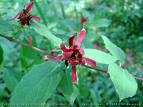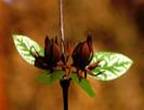| Kingdom | Plantae |
| unranked | Angiosperm |
| unranked | Magnoliids |
| Order | Laurales |
| Family | Calycanthaceae |
| Genus | Calycanthus |
| Species | C.floridus |
| Binomial name | Calycanthus floridus |
Other Common Names:
The other common name for the plant calycanthus are Sweetshrub, Carolina allspice, strawberry shrub and Pineapple shrub.
History
Calycanthus is a genus of flowering plants native to North America and also known as Carolina allspice. This is a wonderful, deciduous shrub with shiny green leaves and carmine magnolia-like flowers.


Description
Eastern sweetshrub or Carolina allspice is a 6-12 ft., deciduous shrub with glossy, aromatic, leathery, dark-green foliage. It's with erect; multiple stems create a rounded outline and can colonize into a clump. The sweet shrub bush has opposite, simple, smooth-margined leaves. The leaves usually turn yellow before leaf drop. But the most notable feature of this plant is fragrance. The petals of the brownish maroon to red magnolia-like flowers integrate with the sepals.


Range
Calycanthus floridus is native to eastern North America and is also found in the moist woodlands of the southeastern United States. Its range extends from Virginia, south to Florida, and west to Mississippi. It also grows well in Australia and New Zealand.
Habitat
Sweetshrub thrives best in forest or natural area in low woods, clearings and along stream banks; landscape as native, cultivated flowering shrub. It either grows in full sun or shade or likes moist rich soil.
Cultivation
This ornamental plant though prefers a sunny position but it tolerates shade when grown in warm temperate zones. Seed are best sown in a cold frame as soon as it is ripe. If the seed is harvested 'green' as soon as it has fully developed but before it has dried on the plant and sown immediately it can germinate in 3 weeks. Dried seed germinates in 1 - 6 months at 15c.Stored seed requires between 3 weeks and 3 months cold stratification before sowing in the spring. When large enough to handle, prick out the seedlings into individual pots and grow them on in the greenhouse for their first winter. Plant out in late spring or early summer of the following year. Cuttings of half-ripe wood take place in July or August in a frame and layering in spring. Sever the new plants in a wet spell of weather about 15 months later and then lift them in the autumn. They can be planted straight out into their permanent positions if required. Sweetshrub requires a sheltered position to protect from cold winds.
Flowering Season
The dark brown or the maroon flowers of the sweetshrub are in bloom from May through July. Blooms first appear in mid spring and continue into mid summer.
Pests and Diseases
Calycanthus floridus is very resistant to disease and insect problems. Plants in this genus are notably resistant to honey fungus. It has a prolific suckering habit, adapts to many soils and grows taller in shaded places. Rarely white-footed mice and downy woodpeckers hammer away the sacs so as to get to the seeds.
Parts Used
The barks, roots and the flowers are the most commonly used parts of the plant for its commercial, medicinal and of ornamental value.
Medicinal Applications

• Sweetshrub is used as a condiment where the leaves, root and bark are dried and used as a substitute for cinnamon.
• It is medicinally used as a diuretic and emmenagogue.
• An infusion of the bark has been used to treat urinary problems.
• The roots are used as an emetic to make eye drops for treating eye problems.
• The ooze of the bark is used for treating sores in children.
Commercial Applications


• Sweetshrub is also nice in planters near entryways and patios where its delicate fragrance can be enjoyed.
• Dry the flowers, leaves, twigs and bark to use in potpourri.
• Its interesting foliage and flowers also provide beautiful spring and summer backdrops for shorter shrubs and flowering perennials.


The maroon flowers of this shrub have a "vinegary" odor, but the leaves have a pleasant, spicy smell. The name "Bubby Bush" comes from the practice of the mountain women putting crushed leaves in their dress tops to make they smell nice. The entire plant is aromatic and thus has been used for its fragrance and to flavour foods despite the possibility of toxicity.